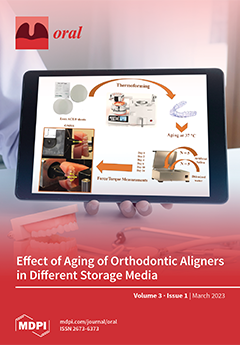Open AccessEditor’s ChoiceCommunication
Oral Toxicities in Cancer Patients, Who Receive Immunotherapy: A Case Series of 24 Patients
by
Ourania Nicolatou-Galitis, Amanda Psyrri, Nikolaos Tsoukalas, Evangelos Galitis, Helena Linardou, Dimitra Galiti, Ilias Athansiadis, Despoina Kalapanida, Evangelia Razis, Nikolaos Katirtzoglou, Nikolaos Kentepozidis, Paraskevas Kosmidis, Flora Stavridi, Efthimios Kyrodimos, Danai Daliani, George Tsironis, Giannis Mountzios, Sofia Karageorgopoulou, Panagiotis Gouveris and Konstantinos Syrigos
Cited by 1 | Viewed by 2695
Abstract
The oral problems of 24 cancer patients on immunotherapy between 2017–2022 and referred by their oncologists, were reported. The age range was 49–80 years, and the median was 64 years. Lung cancer was the most common disease. Three patients a had history of
[...] Read more.
The oral problems of 24 cancer patients on immunotherapy between 2017–2022 and referred by their oncologists, were reported. The age range was 49–80 years, and the median was 64 years. Lung cancer was the most common disease. Three patients a had history of autoimmune disease prior to cancer diagnosis. Patients received immunotherapy for two to 48 months. Prior to immunotherapy, 17 patients received cytotoxic chemotherapy, five angiogenesis inhibitors and one1 radiotherapy to head/neck. During immunotherapy, four patients received chemotherapy, one received bevacizumab, and eight received bone targeting agents, either alone or in combination. Presenting symptoms were oral pain (18 patients, 75%), dental pain (five patients), xerostomia (five patients), burning/itching (seven patients), bleeding (three patients), swelling (three patients), and taste problems (dysgeusia) (three patients). One patient was asymptomatic. Immune-related lesions were observed in 15 patients (62.50%), of which three were exacerbations of prior autoimmune disease. Three patients reported severe deterioration and itching after using a mouthwash. We also observed six (25%) infections (four candidiasis and two herpes simplex), and six (25.00%) cases of medication-related osteonecrosis of the jaw (MRONJ). Five of those MRONJ cases developed among the eight patients with the administration of bone targeting agents and one in a patient with bevacizumab. Two patients presented with more than one lesion. In conclusion, immune-related lesions were most common; oral infections and MRONJ were also observed. Various oral complications might be related to the interplay between immunotherapy and other therapies prior or concurrent to immunotherapy.
Full article
►▼
Show Figures



